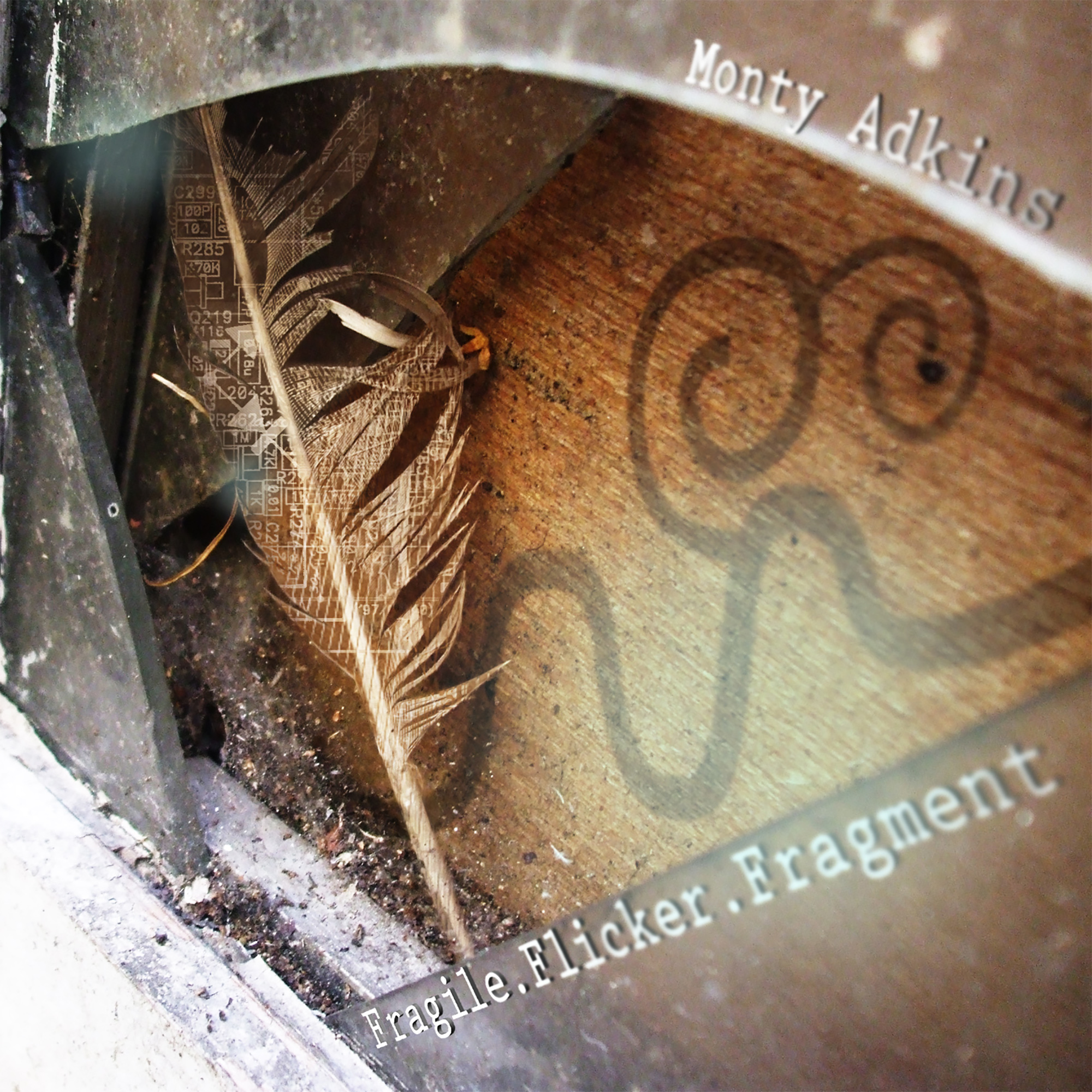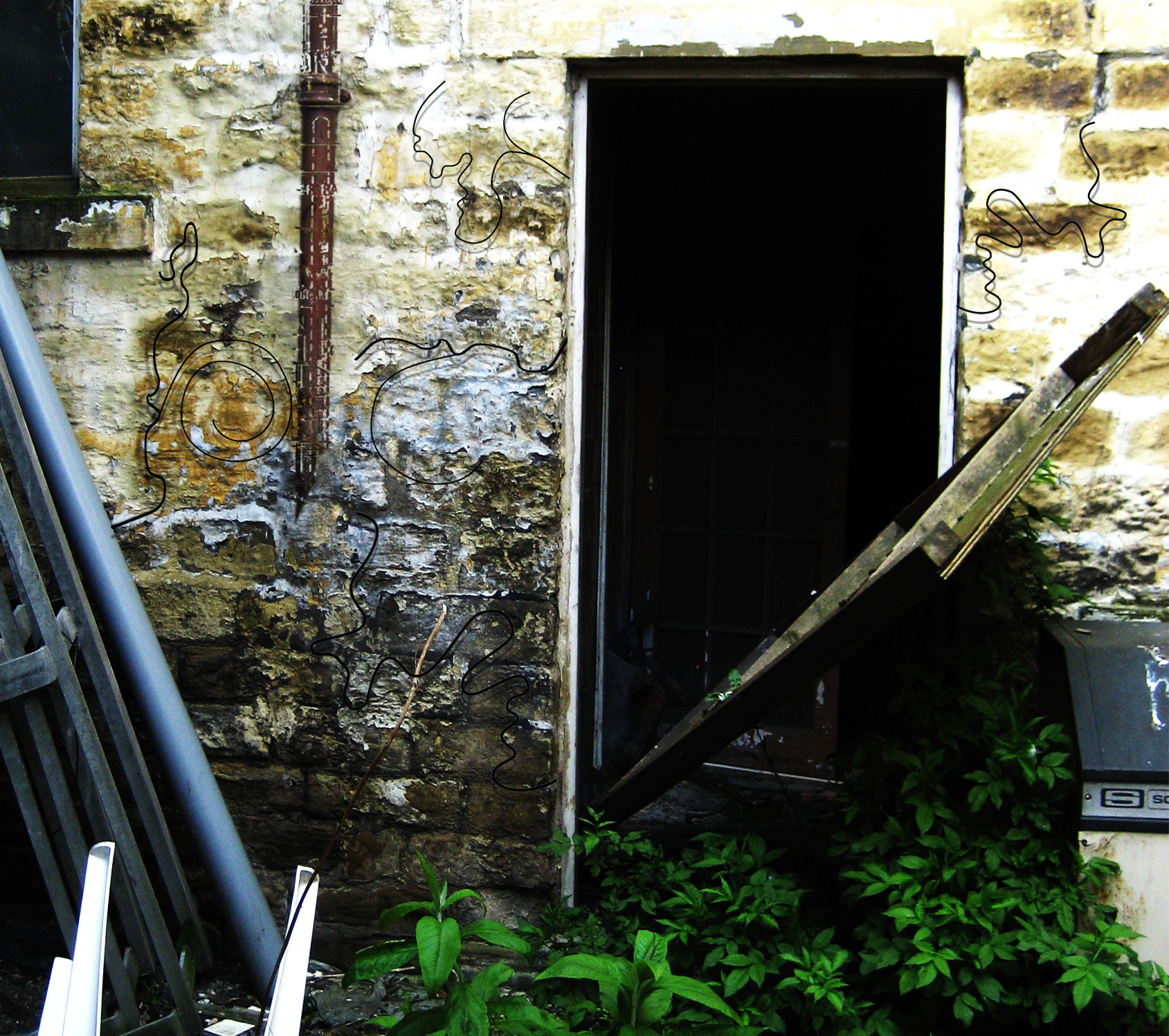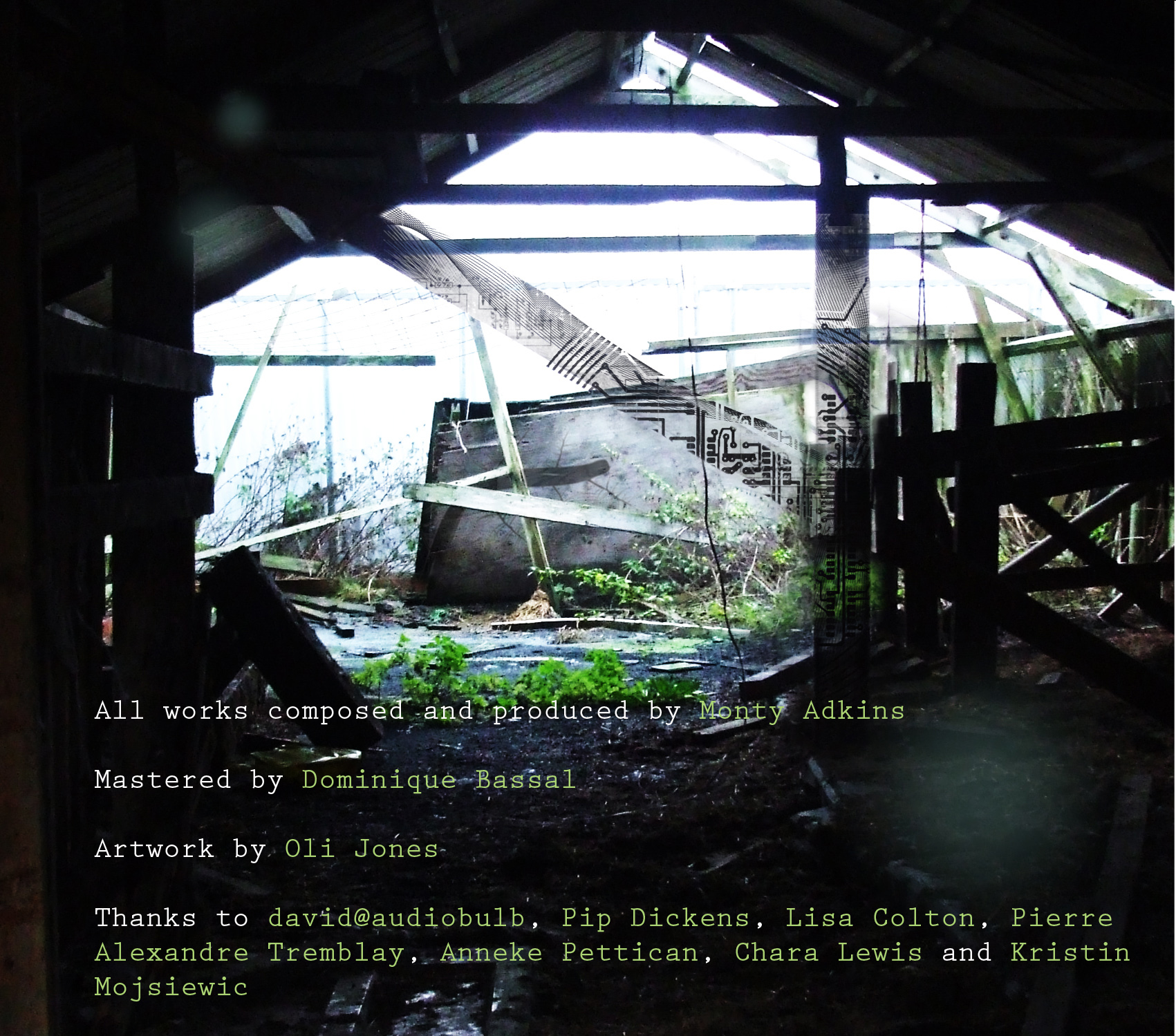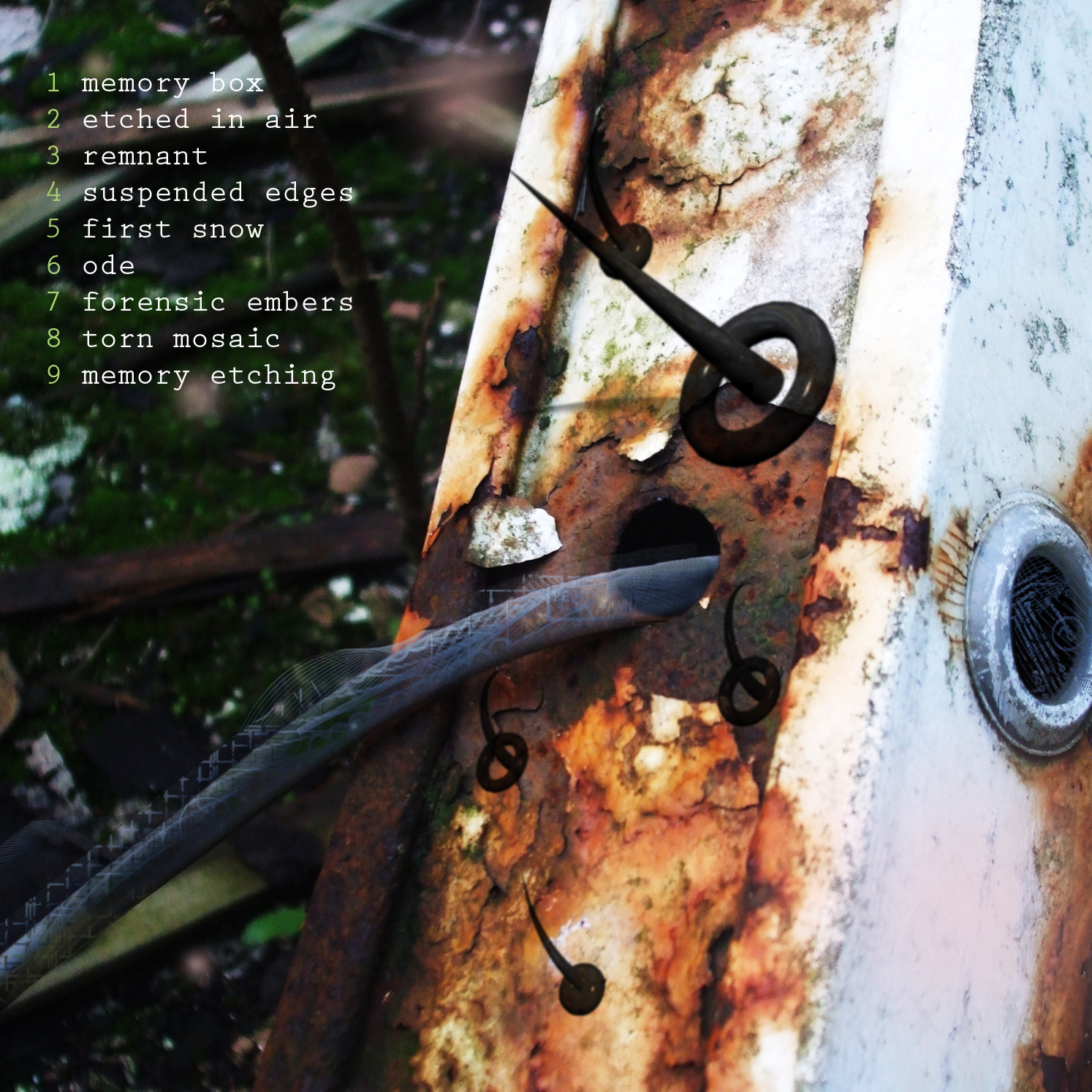
Fragile.Flicker.Fragment
A deeply moving album from Monty's technical and intuitive grasp on sound design and composition. Every frequency is beautifully catered for in these tracks of shimmering acousmatic beauty and deeply resonating foundations. Each layer occupying its own place whilst building the overall acoustic experience. Adkins’ quest to reconcile abstract electronic sound material and melody is explored in this album. This is further strengthened by the inherent visual quality to the tracks, reflecting the relationship between his work and paintings by Pip Dickens (with whom he had begun to collaborate with).
In his own words, “Although I am interested in experimental sound I never start off from this point consciously. To me my music is a reflection of my humanity, the people around me and the friends who play on and record samples for albums. The tracks that eventually emerge are a result of my thoughts, emotions and relationships at that time.”


Monty Adkins
Monty Adkins is a composer and performer whose music is characterised by slow shifting organic instrumental and concrete soundscapes. Having worked across a number of genres since 1994 his work has, since 2006, become increasingly minimal and introspective. This recent work focuses on encouraging a deeper immersive listening experience. Working with a reduced sonic palette Adkins draws together elements from ambient, minimal electronica, acousmatic and experimental electronic music. His last album Five Panels released in April 2009 on Signature/Radio France was nominated in the 'album of the year' category at the 2010 Qwartz Awards, Paris and has now been licensed to Renault.
Interview
Who are you?
Monty Adkins
Why do you write music?
The reasons have changed over the years. When I was young I was involved in a huge variety of music both playing and singing. As a chorister I literally had to sing for my supper. What I remember most about these early experiences was the way the music interacted with these huge cavernous buildings. I think this is a quality that is still there in my music - the way intimate sounds can develop into these huge sound textures that imply a massive space. You can hear this particularly on Ode on the new album. My earliest attempts to write music were really to make sound for these huge spaces - I loved the physical sensation of it.
As I got more and more into electronics making music became more and more a means for self-expression. Although I am interested in experimental sound I never start off from this point consciously. To me my music is a reflection of my humanity, the people around me and the friends who play on and record samples for albums. The tracks that eventually emerge are a result of my thoughts, emotions and relationships at that time.
How would you describe your music?
A simple melody deconstructed, processed and processed and then reassembled. In a way it's a little like the 'Cage' paintings of Gerhard Richter where he starts with very simple blocks of colour - he then adds layer on layer of paint often obscuring most of the previous layer but not all of it to create these beautiful abstract works. From a sonic point of view it draws on a variety of influences from ambient, oceanic glitch, microsound and experimental electronic music.
What does this album mean to you?
For a long time I was more interested in 'sound' rather than the traditional elements of music like harmony and melody. Fragile.Flicker.Fragment is a really important album for me and follows on from my previous one, Five Panels where I started to reconcile abstract electronic sound material and melody. This is something I really wanted to explore in this album. It's also an important album for me as many of the tracks are based on paintings by Pip Dickens and marks the start of a really interesting collaboration with her.
Can you elaborate on some of your creative processes?
I always start with a clear concept of what I'm doing. I record some initial material and then intuitively develop it in a variety of ways often using small patches in Max/MSP and Reaktor that I've slowly developed and collected. I then often live with the sounds for a while, absorb myself in them to see what other thoughts, connections or ideas may develop. Often the process of mixing the final track happens quite quickly.
What are your future plans?
I'm currently working on a new album for release in November 2011 to coincide with a big new exhibition of paintings by Pip Dickens. The album will follow on from Fragile.Flicker.Fragment in its exploration of instruments and electronics. The live show will include me on electronics and the fantastic Canadian clarinettist Heather Roche.
Reviews
The Milk Factory
After reading music at Cambridge University, specializing in French medieval and Italian Renaissance music, Monty Adkins became interested in electronic and electro-acoustic music and went on to become a member of the Birmingham Electro-acoustic Sound Theatre, a formation attached to the music department at the University of Birmingham. This led him to work on very diverse projects, from sound installations and scoring for a contemporary dance piece to curating a project for INA-GRM to celebrate the work of Pierre Schaefer, the man widely regarded as the father of musique concrète.
Adkins’s last record, Five Panels, recorded with bass guitarist Pierre Alexandre Tremblay, was inspired by the paintings of Mark Rothko. Equally, his latest opus finds its source in the work of London-based painter Pip Dickens and that of Brass Art, a collective of artists based in Manchester (Chara Lewis), Huddersfield (Kristin Mojsiewicz) and Glasgow (Anneke Pettican). While Adkins plays a range of instruments here (clarinet, electric guitar, accordion and organ), and also provide vocal inputs, the album features contributions from Lisa Colton (viol) and Tremblay (music box). These acoustic sources are then processed into wonderfully fluid ambient pieces which often feel extremely dreamy.
Memory Box opens this album with delicate music box motifs which appear to progressively be echoed in much subdued form in the backdrop, with additional field recordings dropped in to add glitches and texture. This is also how Adkins choses to close the album, but, if anything, the mood is even more subdued and ethereal on Memory Etching, with the music box notes becoming as light and clear as raindrops. In between, Adkins creates a splendid series of varied soundscapes which develop into sumptuous pieces, ranging from the lush and vaporous Etched In Air or Remnant, which both sound like psychedelic electronic endeavours as heard through a thick hallucinogenic haze, slowed down to a point of near immobility. While the sound sources are virtually unidentifiable in these two pieces, Suspended Edges reveals its core component, an organ, from the start and continues to build on its warm and rounded sounds. Elsewhere, the sound sources are even more obvious. The music box makes another appearance on First Snow, but here, the sounds are treated and looped into tight sequences and pressed into a much more confined space, scintillating brightly, albeit somewhat briefly. An accordion gently swells on the spiralling Ode, and viol on the moody Torn Mosaic, Lisa Colton providing a series of suitably mournful motifs which Adkins fragments or expands, adding occasional earthy found sounds.
All throughout, Monty Adkins create extremely delicate miniature structures which, as the album title indicates, appear to flicker constantly, like tiny beacons of light in the night, their refined forms developing in the most fluid fashion. Adkins processes his sound sources with great care, placing them as to get the best out of every single one of them. Rating: 4.6 / 5
Igloo Magazine
Composer Monty Adkins was educated at Pembroke College, Cambridge, United Kingdom, where he read music, specializing in French Medieval and Italian Renaissance music. After being introduced to the electronic genre, he later would become a member of the Birmingham electroacoustic sound theatre.
Fragile.Flicker.Fragment. rather accurately describes the content of this offering. It’s a dainty trinket box, ever so fragile, full of mysterious blends and fragments of organic surfaces that almost flicker. There’s integration of subtle field recordings, which add a realistic undercurrent alongside its dreamy aspect.
The whole album pretty much follows a similar theme throughout with perhaps one or two more diverse excursions further in. “Memory Box” being exactly typical. Filled with gentle chimes, light in approach, but with a penetrating depth of mystery and a pull towards the tracks increasing presence. Embraced by intermittent rustle, and dressed in that mysterious presence created by distinct wind chimes that chatter throughout. Metallic depth would be a common theme on this record and “Etched in Air” is no exception. Born out of its own creative path, it vibrates lovingly; a testament to the fresh approach of this release. Selectively searching with a display of moving imagery, vast, vibrant and dilated.
“Remnant” shows an underlying strength; it’s another watery mission that presents itself in a quiet before the storm sense, with deep penetrating bass lines that colour the track while enabling the higher pitches to illuminate quite successfully over its deeper, more expanding layers as it progresses. Plenty of overtones that compliment, and there’s an almost underwater feel midway, but it doesn’t stop there. With yet more watery timbres is “Suspended Edges,” a very brief experiment clocking in at just a minute, with unrestricted drive with plenty of mythological character. “First Snow” feels like a reflection of “Memory Box” with yet more extravagant chime offset against computerized bleeps.
“Ode” is a refreshing listen in that different qualities take hold here for the first time, generated by gypsy accordion styled sounds that introduce the excursion, governing throughout and successfully introducing the contrast the album needs at this point, with its wonderful dense fabric.
There’s a deep wave of bass that gives nothing away here – where “Forensic Embers” might lead is unclear, but its tone reaches deep to the intensity of existence – a regulated movement of little distraction.
Overall Fragile.Flicker.Fragment. is an affectionate tuneful application of instrumentation that gives way to plural watery textures of organic sound construction and mythological extract resulting in a calming electronic spectrum.
Textura
Though it might not be readily apparent from the package design for Monty Adkins' fragile.flicker.fragment, the recording's nine settings were developed alongside the visual artwork of Pip Dickens and the Brass Art collective. It's not an insignificant detail as Adkins material is extremely vivid and visually suggestive, one of those electro- acoustic cases wherein imagery forms almost instantly in response to the sounds presented. More precisely, Adkins doesn't take his inspiration from visual artists but has approached the music's production in such a way that he's taken the techniques used by artists working within the digital glitch art field and applied them to experimental electronic music production methodology with the aid of software expressly created for that purpose. Noting glitch theorist Iman Moradi's identification of four characteristics associated with the visual field in question (fragmentation, repetition, linearity, and complexity), Adkins adopts such techniques in the creation of his own electronic music pieces. Be that as it may, fragile.flicker.fragment doesn't always sound radically unlike glitch-laden electronic music as it's come to be known; familiar textural sounds of ripples, static, and smears occasionally pepper the tracks, a fact that helps position Adkins' album comfortably within the genre itself. During “Remnant,” for example, tones push through rippling masses of distressed electronic noises in a way that won't be unfamiliar to electronic music devotees.
Not that there's anything objectionable about that, mind you. Adkins' patiently unfolding pieces are appealing no matter how much they may or may not align themselves with others in the genre. Generally speaking, they could be described as ambient electronic soundscapes that Adkins (along with two well-chosen guests, Pierre Alexandre Tremblay on music box and Lisa Colton on viol) enhances with the natural sounds of clarinet, electric guitar,accordion, and organ. The material is hardly thrown together, either, as Adkins brings a formidable background to the project: he studied at Pembroke College, Cambridge; formally studied acousmatic music; and his 2009 Five Panels album (featuring Adkins on e-guitar and organ and Tremblay on bass) was nominated for a 2010 Qwartz Award.
Electro-acoustic meditations emphasizing the integration of music box playing and electronics, the opening and closing pieces, “Memory Box” and “Memory Etching,” serve as framing pieces for the album. After the music box interlude “First Snow,” Adkins breaks out of the album's largely restrained mode during “Ode,” which begins as a mournful setting featuring accordion smears that, in its more conventional melodic moments, calls to mind Astor Piazzolla's bandoneon playing, before swelling dramatically. “Forensic Embers” crests with a Ligeti-esque flourish at its tail end, after which Colton's viol occupies the forefront of “Torn Mosaic,” though her string playing is but one sound of many, as shuddering electronics and textural noise are prominent too. The association with early music that the viol brings with it makes for an ear-catching juxtaposition with electronic elements that obviously sound modern next to it. As should be obvious by now, Adkins wisely shifts the focus from one piece to the next on this commendable outing, which helps keep the listener engaged throughout.
Cyclic Defrost
UK-based electronic producer Monty Adkins primarily creates slow-shifting ambient soundscapes that incorporate organic instrumental textures, and this latest album ‘Fragile.Flicker.Fragment’ follows on from his 2009 collection ‘Five Panels’, which received a nomination in last year’s Qwartz Awards. In this case, the nine expansive beatless tracks collected here see Adkins drawing inspiration from a series of paintings by visual collaborator Pip Dickens, and indeed there’s certainly a highly visual / cinematic quality to the music here, as well as an exquisite level of attention to detail regarding overall sound design. Opening track ‘Memory Box’ introduces the dreamily blurred aesthetic that colours much of this album as glistening, icicle-like melodic tones glimmer against a swirling backdrop of pitch-shifted drones, the sense of tentative wonder recalling SubtractiveLAD’s ambient explorations even as moodier bass tones and fluttering glitchy textures begin to creep into the undergrowth.
By comparison, ‘Etched In Air’ sees a droning backdrop of vocal harmonics stretching off into the horizon as crackling broken electronic detritus and more ominous bass undertones slowly begin to gather pace against the more wide-eyed atmospheres, in what’s easily one of the darker tracks to be found here, before ‘Suspended Edges’ takes things down into deep, subaquatic atmospheres, the occasional pulse of what sounds like air bubbles fluttering against a vast wall of refracting synth drones. ‘Ode’ meanwhile sees the emergence of relatively recognisable instrumental performances as rich, warm accordion tones glimmer and build against a widescreen swell of melodic drones and buzzing electronics, in a moment that pretty much begs for its own cinematic accompaniment. Gorgeously enveloping and meticulously crafted stuff that’s well worth investigating.
Vital WeeklyAlthough around since 1994, I never heard of Monty Adkins, whose previous album ‘Five Panels’ was nominated ‘album of the year’ by Qwartz Awards and then licensed to some car company (how do you pull that off, I wondered). Adkins has worked in a number of genres, but in recent years went more and more towards the minimal and introspective kind of music. The title sums up the music quite well, I think. Its fragile music that flickers away and in which fragments are used to create a fine whole unity of a composition. This is ambient music of a modern nature. Open, spacious, computerized, but based on acoustic sources. The opening ‘Memory Box’ deals with the sound of music box and in other pieces we hear guitars or violins (merely guessing actually). Sometimes a piece doesn’t give anything away of the original source material and it seems to exist in a mere digital environment. Its hardly music that we haven’t heard before, mainly on the 12K label – to mention one very obvious point of reference. That said, what is original anyway, and should we care? Perhaps we shouldn’t and just go by the music. Adkins does a great job at what he does and perhaps that’s all that should matter. Nine fine pieces of abstract ambient music. Nine pieces of computerized warmth. That’s all that matters. Maybe Adkins should consider to make it all a bit more of his own though. His skills seem to be up for it. (FdW).
We Are An American BlogWhen Professor Monty Adkins is not teaching music students at England’s University of Huddersfield, he is researching and recording sounds in many different formats. He describes his latest release, 2011's Fragile. Flicker.Fragment (Audiobulb), as “Slow shifting organic instrumental and concrete soundscapes.” He is part of a fascinating group of musical pioneers in electroacoustic music.
The term “electroacoustic music” is somewhat broad as it covers a wide range of sound experimentation. Some of the forms include musique concrete, computer music, tape music — basically electronic music of all sorts. It is no surprise that he is recording for Audiobulb, who are dedicated to “exploratory electronic music.” Although Adkins has released a number of solo recordings and has appeared on quite a few compilations, Fragile.Flicker.Fragment is his first effort for the label.
In his official biography Adkins explains the various strands of the movement he has explored over the years. For the purposes of this review, the following quote is particularly illuminating: “Recently the work has become increasingly minimal and introspective. This work focuses on encouraging a deeper immersive listening experience. Working with a reduced sonic palette, the new works draw together elements from ambient, minimal electronica, acousmatic and experimental electronic music.”
The emphasis on the intellectual side of things is understandable for a professor, but I think it also tends to alienate the “average” listener such as myself. It is one thing to understand the conceptual framework of these tracks, but in the end one does not need to be a musicologist to enjoy this recording. I knew next to nothing about Professor Adkins before listening to Fragile.Flicker.Fragment, and it did not matter in the least. For the most part, the nine tracks fall into the ambient minimalism category, with some notable exceptions.
The disc opens up with “Memory Box,” a very inviting piece utilizing what sounds like “tubular bells“ to me. I actually have no idea as to what specific instruments were used on the album or whether it was created entirely electronically, so I can only describe what I hear. The moods created by Adkins are what count, and they are varied, and often quite beautiful. “Remnant” evokes an air of mystery, where “Ode” is probably the most raucous track.
The most experimental piece is quite appropriately titled “Torn Mosaic.” This is by far the longest track on the disc, clocking in a 11:30. Adkins pulls out all the stops here, beginning with some very “futuristic” tones, underscored by a nice, very ambient bed of sound. Following this portion, we hear the intriguing tones of an of instrument that sounds very much like a harmonium. The ending is a long, low drone, sprinkled with intermittent flourishes. I must say that I found “Torn Mosaic” to be a very impressive sound-sculpture.
The ninth and final track, “Memory Etching,” is also quite experimental in nature, although not quite as long or involved as “Torn Mosaic.” As with all of the Audiobulb releases, detailed information is available on their website, as well as ordering options. Monty Adkins’ second Audiobulb recording, titled Four Shibusa, is set for release in April, and is one I am highly anticipating.
Coke Machine GlowAnyone familiar with Ennio Morricone’s The Thing (1982) score will know you can squeeze a lot of tension out of a single note. OK, so the film’s scenes of Kurt Russell going stir crazy/stop-motion head spiders brought plenty of menace on their own, but there’s no denying the film became slightly icier thanks to Morricone’s bleak monotone overdubs.
Monty Adkins must’ve rented The Thing at a very inappropriate age, because his sound—“slow shifting organic, instrumental and concrete soundscapes”—mirrors the Antarctic horror film so accurately you can almost hear penguins trying to flee from it. Adkins spent his degree years taking single noises and converting them into complex drone operas, resulting in his work being farmed out and given lots of art spots in France. After a short break playing e-guitar in Paris, Adkins has gone back to his favourite whiteouts for sophomore album fragile.flicker. fragment, where single notes enjoy extraordinary production, like Ennio Morricone striking a power chord and then running outside to catch the fade.
Unusually for an ambient record, Adkins has decided to telegraph his album with a decade, and as soon as “Forensic Embers” begins it’s obvious we’re deep in the ’80s. The mix of drone, pads and slow laser scanners could easily be a Knight Rider cue, and by the time the synthetic rain effects come in you’ll want to cry “Vangelis impersonator!” But Adkins lets his soundscapes glow and boil over, going into places TV pop culture avoids. All that time in French art galleries has altered his vision, allowing him to play with the track’s titular darkness in a way that would make the titular pathologists uncomfortable. And although the detail on “Forensic Embers” might not be original enough to get a murder conviction reversed, it’s certainly a good enough alternative to the retro copycats of the ’80s, who only want to wipe out crime and aliens and keep David Hasselhoff alive.
